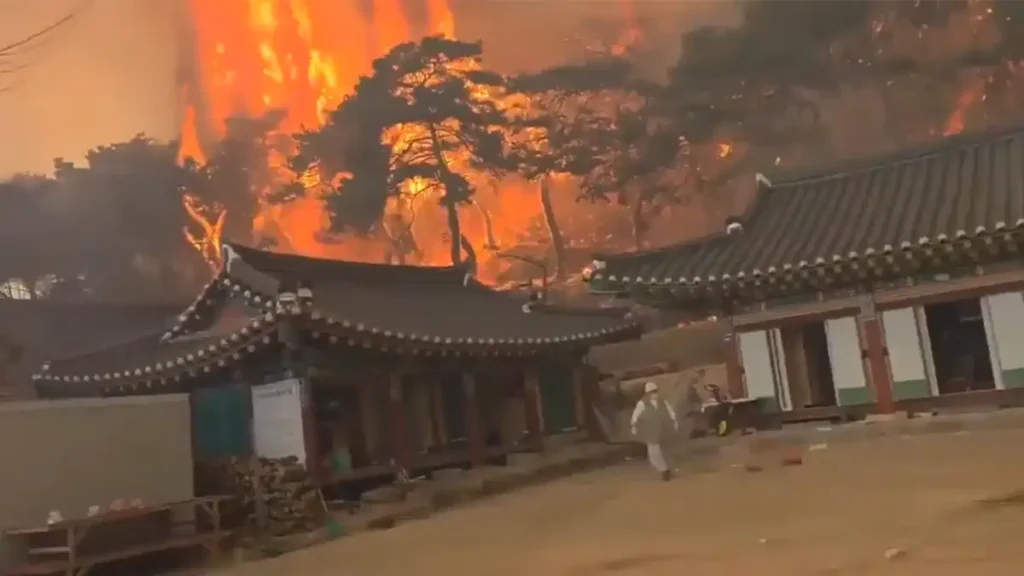Gowonsa Temple, the headquarters of the 16th Diocese of the Jogye sect of Korean Buddhism, was completely destroyed by a wildfire in Uiheung. According to forestry authorities, on March 25, at 4:50 p.m., Gowonsa Temple, the headquarters of the 16th Diocese of the Jogye sect of Korean Buddhism, located at the foot of Dwaeunsan Mountain in Danchon-myeon, Uiheung-gun, was completely destroyed by a wildfire.

Founded in the first year of Silla’s New King Shinwon (681 AD) by King Sangsangdaesa, Gowonsa was one of the largest temples in Gyeongsangbuk-do. The tangible cultural heritage, including Treasure No. 246, a stone statue of Nyorae, was moved to various parts of Gyeongbuk earlier that day.
‘Gowonsa’ Temple homepage
About Gowonsa Temple
Gowonsa Temple was founded in the first year of King Silla’s reign (681 AD) by the eponymous founder of the Haedong Hwaeum sect. The temple, located in the Cheonhaemyeongdang Hall, which is shaped like a half lotus flower, was originally called Takunji Temple.
After Choi Chi-won, who was said to have become a god by mastering both Silla Buddhism and Confucianism and Taoism, built the Gungnaru (Gyeongbuk Tangible Cultural Property No. 151) and Wuhworu with Queen Yeoji and Queen Yeosa, the temple was renamed Gungunji Temple in honor of his name, Gungun.
The temple was founded by Doseonguksa, a teacher of Wanggun of the Taejo Dynasty of Goryeo Dynasty, who is considered to be the ancestor of the Fengshui school of thought, and it is said that the temple had a size of 五法堂十房舍 (five dharma halls and ten yosachae) at that time.
The existing Buddha in Yaksajeon Hall (Treasure No. 246) and the three-story stone pagoda in front of Nahanjeon Hall (Gyeongbuk Cultural Heritage Data No. 28) were built by Doseonguksa.
In particular, Gowonsa Temple is a sacred place for the Jizo Bodhisattva, the first Jizo Bodhisattva to thaw.
Since ancient times, it has been said that when he died and went to the afterlife, King Yeomradaewang asked him if he had visited Gowonsa Temple, and not only does Jizo Bodhisattva’s benevolent characteristic, but also the name and costume of the Ten Kings of Myeongbu, which are rarely seen in other temples, boast majesty and sophistication.
During the Japanese occupation, the temple was one of the 31 general headquarters of Joseon Buddhism and is now the headquarters of the 16th Diocese of Jogye Buddhism, overseeing more than 60 large and small temples scattered in Uisung, Andong, Yeongju, Bonghwa, and Yeongyang.
At the height of its prosperity, Daedorum, which had 366 buildings and 200 worshippers, fell into disrepair after liberation, destroying many temple properties and reducing it to a small diocesan headquarters with only 20 worshippers.
However, since about a decade ago, the temple has been organizing the surroundings and repairing and refurbishing the old buildings with the enthusiastic efforts of the Jungchang Buddhist monastery, and now the majestic status of the main temple and the image of a simple and restrained place to practice are in exquisite harmony.
The only temple of its size in the country that does not charge an entrance fee, Gowonsa Temple is located about 3 kilometers away from the main temple, and the dirt road through the pineyards leading up to the main temple is as warm and welcoming as the hearts of the Buddhists who approach it with sincere devotion.
The monks and all the public of Gowonsa Temple, including the monks who devote themselves to the clean and strict asceticism of Gogeumdang Seonwon, never stop coming to the Buddha Temple in the cold air of dawn to seek the truth from above and to embody the true aspect of Mahayana Buddhism, which is the institution of sentient beings from below.
※ Adapted from Gounsa Temple website
Gowonsa Temple History
History 681 AD
(1st year of King Shinshin of Silla) Ambassador Sangsang founded Gowonsa Temple
Choi Chi-won built the gungnaru and wuhwaru with the ambassadors Yeoji and Yeosa.
Changed to Gowunsa (孤雲寺)
1990
Jonggak and Gogeumdangseonwon built
Pharmacopoeia restored
1998
Built Gowundaeam, Yongwangdang, Daedanggak, Yeonjiam, and Sannamun
Relocated Samgak
2004
Built Budotap
2005
Established Gowoon Silvi Nursing Home for the Elderly
2007
Established the Zen Experience Center
2008
Established Sewolam Restoration Center
Establishment of Beokgye Road
Renovation of Iljumun
Established Andong Youth Culture Center
2009
Restoration of Hwaeumseungga Graduate School
Renovation of Jongmu Office
2010
Built a library, restrooms, and showers for Hwaham Sangha Graduate School
Restrooms renovated
2012
Built the temple food experience center
2015
Built Hwaham Cultural Temple Center
[Related articles]


